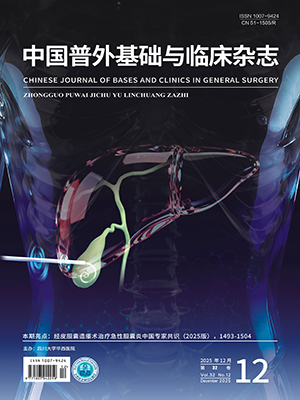| 1. |
中國抗癌協會乳腺癌專業委員會. 中國抗癌協會乳腺癌診治指南與規范(2017 版). 中國癌癥雜志, 2017, 27(9): 695-698.
|
| 2. |
胡夕春, 王碧云, 邵志敏. 2011 年《St.Gallen 共識》與中國抗癌協會, 乳腺癌專業委員會指南之比較. 中華乳腺病雜志 (電子版), 2011, 5(4): 404-407.
|
| 3. |
Chavez-Macgregor M, Clarke CA, Lichtensztajn DY, et al. Delayed initiation of adjuvant chemotherapy among patients with breast cancer. JAMA Oncol, 2016, 2(3): 322-329.
|
| 4. |
Palmieri C, Jones A. The 2011 EBCTCG pllychemotherapy overview. Lancet, 2012, 379(9814): 390-392.
|
| 5. |
Perou CM, Sorlie T, Eisen MB, et al. Molecular portraits of human breast tumours. Nature, 2000, 406(6797): 747-752.
|
| 6. |
S?rlie T, Perou CM, Tibshirani R, et al. Gene expression patterns of breast carcinomas distinguish tumor subclasses with clinical implications. Proc Natl Acad Sci USA, 2001, 98(19): 10869-10874.
|
| 7. |
van't Veer LJ, Dai H, van de Vijver MJ, et al. Gene expression profiling predicts clinical outcome of breast cancer. Nature, 2002, 415(6871): 530-536.
|
| 8. |
美國東部腫瘤協作組. 體能狀態評分 ECOG 評分法. 中華普通外科文獻 (電子版), 2012, 6(6): 556.
|
| 9. |
Common Terminology Criteria for Adverse Events (CTCAE) v4.0. June 14, 2010. https://ctep.cancer.gov/protocoldevelopment/electronic_applications/ctc.htm.
|
| 10. |
Trotti A, Colevas AD, Setser A, et al. CTCAE v3.0: development of a comprehensive grading system for the adverse effects of cancer treatment. Semin Radiat Oncol, 2003, 13(3): 176-181.
|
| 11. |
中國臨床腫瘤學會指南工作委員會. 腫瘤放化療相關中性粒細胞減少癥規范化管理指南. 中華腫瘤雜志, 2017, 39(11): 868-878.
|
| 12. |
Eisenhauer EA, Therasse P, Bogaerts J, et al. New response evaluation criteria in solid tumours: revised RECIST guideline (version 1.1). Eur J Cancer, 2009, 45(2): 228-247.
|
| 13. |
Berruti A, Amoroso V, Gallo F, et al. Pathologic complete response as a potential surrogate for the clinical outcome in patients with breast cancer after neoadjuvant therapy: a meta-regression of 29 randomized prospective studies. J Clin Oncol, 2014, 32(34): 3883-3891.
|
| 14. |
Cortazar P, Zhang L, Untch M, et al. Pathological complete response and long-term clinical benefit in breast cancer: the CTNeoBC pooled analysis. Lancet Lond Engl, 2014, 384(9938): 164-172.
|
| 15. |
Gralow JR, Brustein HJ, Wood W, et al. Preoperative therapy in invasive braast cancer: pathologic assessment and systemic therapy issuses in operable disease. J Clin Oncol, 2008, 26(5): 814-819.
|
| 16. |
Kaufmann M, von Minckwitz G, Bear HD, et al. Recommendations from an international expert panel on the use of neoadjuvant (primary) systemic treatment of operable breast cancer:new perspectives 2006. Ann Oncol, 2007, 18(12): 1927-1934.
|
| 17. |
Mauri D, Pavlidis N, Ioannidis JP. Neoadjuvant versus adjuvant systemic treatment in breast cancer: a meta-analysis. J Natl Cancer Inst, 2005, 97(3): 188-194.
|
| 18. |
張玲菡, 柳梅, 龔燦, 等. 新輔助化療后乳腺癌保乳手術問題現狀. 中國普外基礎與臨床雜志, 2018, 25(2): 154-160.
|
| 19. |
Esteva FJ, Hortobagyi GN. Can early response assessment guide neoadjuvant chemotherapy in early-stage breast cancer? J Natl Cancer Inst, 2008, 100(8): 521-523.
|
| 20. |
譚龍濤, 滕曉飛, 程凱, 等. 乳腺癌新輔助化療療效生物學預測指標的研究進展. 中國普外基礎與臨床雜志, 2017, 24(12): 1546-1550.
|
| 21. |
Thomas E, Holmes FA, Smith TL, et al. The use of alternate, non-cross-resistant adjuvant chemotherapy on the basis of pathologic response to a neoadjuvant doxorubicin-based regimen in women with operable breast cancer: long-term results from a prospective randomized trial. J Clin Oncol, 2004, 22(12): 2294-2302.
|
| 22. |
Volders JH, Negenborn VL, Spronk PE, et al. Breast-coserving surgery following neoadjuvant therapy systematic review on surgical outcomes. Breast cancer Res Treat, 2018, 168(1): 1-12.
|
| 23. |
Von Minckwitz G, Untch M, Blohmer JU, et al. Definition and impact of patholocic complete response on prognosis after neoadjuvant chemotherepy in various intrinsic cancer subtypes. J Clin Oncl, 2012, 30(15): 1796-1804.
|
| 24. |
Banerjl S, Cibulskis K, Rangel-Escareno C, et al. Sequence analysis of mutations and translocations across breast cancer subtypes. Nature, 2012, 486(7403): 405-409.
|
| 25. |
Bisso A, Faleschini M, Zampa F, et al. Oncogenic miR-181a/b affect the DNA damage response in aggressive breast cancer. Cell Cycle, 2013, 12(11): 1679-1687.
|




